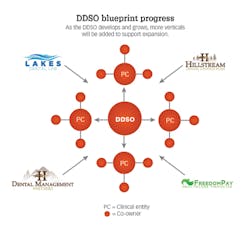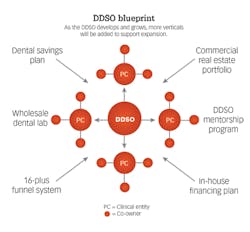DDSO blueprint series, Part 2: The team approach
By Robert Hubbard, DDS, and Justin Leath, DDS
Introduction by Brady Frank, DDS
This five-part series is dedicated to highlighting the top-performing 1% of practices around the country that have successfully converted to a personalized dentist-owned dental support organization (DDSO) model and are reaping the benefits. Using actual examples, actionable steps will be given to help you build your own DDSO blueprint with its affiliated streams of income, tax savings, and funnels.
Let me introduce you now to Justin Leath, DDS, and Rob Hubbard, DDS, owners of two locations in the great state of Michigan. Their group is a wonderful example of reaping benefits through conversion to a DDSO model.
Discussion by Robert Hubbard, DDS, and Justin Leath, DDS
Deciding to transition your practice into a DDSO model takes careful planning. It is not a fast process. In fact, you want to take your time to be sure you are setting a good foundation upon which to build. Patience is critical and you have to respect the process. Before you get started, you should remind yourself that the first step is—paradoxically—the easiest and the most difficult. It occurs within your own mind. Remember placing your first implant? You had to decide and commit that you were ready to place one. This decision and commitment turning point, regardless of the outcome, is called courage. Then you had to acquire the equipment. Then you had to find the right patient. The steps necessary to transition your practice into a DDSO model involve the same process. The steps should be approached and completed in a sequential order, ensuring the easiest route to go from where you are today in dentistry to where you want to be in the future. Once you’ve made the decision and are committed, then you are on your way to the second step: surrounding yourself with a proven team that has done what you plan to do.
Your team is critical to the process of building your DDSO blueprint and supporting you along the way. Gaining traction so you can move forward with speed occurs when you and your team break the process down into smaller, more simplified action items. These action items are digestible, easy to achieve, and are occasionally accomplished solely by the members of your team. This method provides small doses of momentum to keep you moving forward. Before you know it, the process will be further along than you imagined.
Figure 1: A simplified schematic of the growth plans related to a scaling a DDSO like HillStream as it relates to adding specific vertical organizations. All of these value components also become contributions to the DDSO Mentorship Program.
Who are the members of your team? This is no light assignment. Special care should be taken in selecting. It begins with each member sharing your vision and passion to create new opportunities both for your practice and other dentists joining your organization. Among other deciding factors, proven results, years of experience, and trust are paramount. It shouldn’t surprise you that it rests on your shoulders to build and achieve the life of your dreams. Find others who share your vision and want to build it with you.
The important players on your DDSO team will consist of an accountant, a DDSO mentor or coach (people who have already achieved what you would like to achieve), and a good DDSO attorney. Others you deem important should also play a role, such as dental colleagues, real estate agents, wholesale dental labs, and software and tech experts. You and your team will then develop your DDSO blueprint. This is your third step. This is your vision put on paper. Your blueprint will be your starting point and a general plan that your team will flesh out. A DDSO blueprint generally includes, but is not limited to, answers to the following questions:
- How many practices do you want?
- What regions do you want to be in?
- How many partners do you wish to add to your practice(s)?
- What type of entity will you set up?
- What intellectual property do you plan on utilizing?
- Do you plan on holding any real estate?
- Do you plan on using your own money as private equity in acquisitions or real estate purchases?
- In what period of time do you want to accomplish the items on your blueprint?
The list goes on. Once the blueprint is established, keep in mind that it is fluid. It is a living and breathing organism. You must be willing to be flexible and adapt to changes.
Figure 2: HillStream DDSO has incorporated multiple vertical organizations and streams of income to add value to the associated clinical locations. As the group grows, all individual dentists benefit from the economy of scale of the vertical value components (supply discounts, lab discounts, software, branded savings plan, branded in-house financing, marketing, automation funnels, etc.).
The fourth step is execution. One of the most important members of my DDSO blueprint team is Brady Frank, DDS, who has been deep in the private dental group practice environment for close to 20 years. Here is one of my favorite quotes from Tony Robbins, “If you want to achieve success, all you need to do is find a way to model those who have already succeeded.”1 That is the main reason we chose Dr. Frank’s team as our execution partner. We will now hand things back to Dr. Frank, who will highlight the DDSO Mentorship Program, which is an important vertical to our growth, and the concept of the entrepreneurial satellite practice.
Comments by Brady Frank, DDS
I’m so excited about the success Drs. Leath and Hubbard have had with their DDSO model. In fact, I strongly believe that it is the successful private practices of this nation that have the greatest ability to be good stewards and promote practice ownership for new dentists and the next generation. Ever since doing my first lunch and learn on the topic of early-career practice ownership in 2006 at the Oregon Health and Science University School of Dentistry, I have been immersed in mentoring new dentists to early-career ownership success. Having owned multiple practices right out of school, I have found this to be a very natural role for me. Drs. Leath and Hubbard’s DDSO Mentorship Program is similar to the one I started in 2006. However, it has been entirely digitized to accommodate how today’s dentists consume information.
The premise and goals of an effectively executed DDSO Mentorship Program are simple. The new dentist mentee comes to the table with a dental license, the ability to perform dentistry full-time, and the desire to model a top 1% practice in dentistry. The DDSO mentor comes to the table as a huge financial safety net. The mentor has the willingness to pass on years of dental practice management and business wisdom. He or she provides all the vertical components of the DDSO and a structured clinical and business learning environment. The mentor and new dentist mentee coinvest in the “value-added” acquisition, or entrepreneurial satellite practice. The asset grows, increases in value, and both parties benefit through the properly structured relationship. It is a true win-win-win from a cash-flow, equity, and educational standpoint. I only wish DDSO mentorship programs were available when I graduated from dental school!
Author’s note: Get involved in growing dentistry’s private practice sector by committing to mentor our country’s ambitious new dentists. Drs. Leath and Hubbard are doing their part—such as through their authorship of the book, The Avenues to Practice Ownership Success. Commit to growth and then share that growth through co-ownership as dentistry enters a new golden age of practice ownership. Text “Leath” to 31996 for further information on Dr. Frank’s DDSO book. Additional resources may be found at: ddsoblueprint.com, ddsomastery.com, ddsofunnels.com, and theddsoalliance.com.
Reference
1. Brown J. 50 Powerful Tony Robbins Quotes That Have Changed My Life. Addicted to Success website. https://addicted2success.com/quotes/50-powerful-tony-robbins-quotes-that-has-changed-my-life/. Published April 28, 2014.
Brady Frank, DDS, is an international clinical and business lecturer, an inventor, and a founder of multiple companies in the dental space. Since graduating from the Marquette University School of Dentistry in 2001, he has owned multiple private dentist-owned groups (DDSOs). He is a founding member of the DDSO Alliance. Reach him at [email protected].
Ron Hubbard, DDS, and Justin Leath, DDS, are the founders of a two-location, top 1%, private dental group (DDSO) in the state of Michigan. They enjoy educating new and experienced dentists on growth strategies related to multidoctor, multilocation practice ownership, and are founding members of the DDSO Alliance. Dr. Leath is a founding member of the Wholesale Dental Lab Network and lectures on clinical and business topics. To reach them, contact Dr. Leath at [email protected].
Editor’s note:
This article is part two of a five-part series. Part one appeared in June and part three will appear in August. Part one may be found at dentaleconomics.com. Search: “DDSO Blueprint.”
About the Author

Brady Frank, DDS
Brady Frank, DDS, is a third-generation dentist turned entrepreneur, inventor, author, and thought-leader with a passion for teaching others the hard-won lessons he has learned about successfully creating and selling a business. Dr. Frank has expertise on multi-doctor and multi-location private group practices, dental transitions, DSO and DDSO expansion and growth strategies, and healthcare real estate investment, and is most passionate about mentoring others on these topics.


